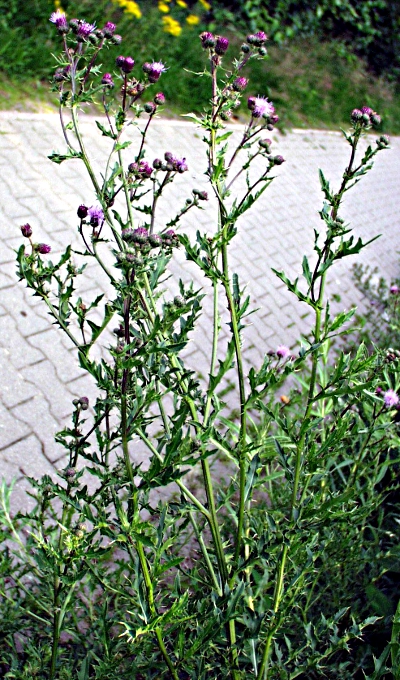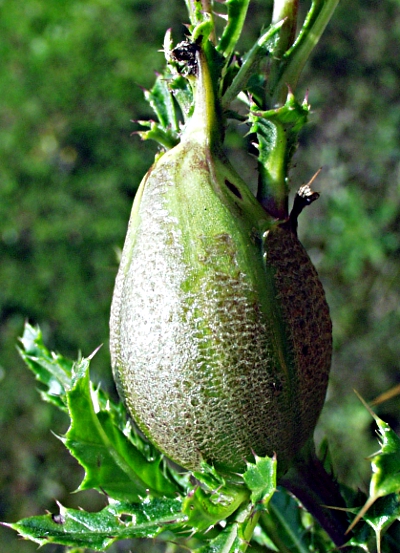Creeping thistle |

Habit of the creeping thistle

Plant gall caused by the Canada thistle gall fly
Flower biology
The creeping thistle, that is often designated as dioecious, in reality is a little more than that. In addition to female flower heads with fertile pistils and sterile stamens there are also those, which bear both fertile stamens and some fertile pistils. This often simply referred to as male flower heads, may well develop fruits, but usually not so numerous as the female ones, because their pistils are often sterile, stunted or just shorter. In addition, their achenes are smaller and the germination capacity is reduced in contrast to the female florets. The creeping thistle, emerged from hermaphroditic ancestors, therefore is dioecious to gynodioecious.
One can distinguish the gender of the florets on the basis of morphology. Female florets have an about 18 mm long corolla with a white, up to 2 mm long, fertile ovary at the base. The 5 corolla lobes are about 4 mm long and linear. The stamens are just 1.6 mm long, arise just below the lobes and have brown, sterile athers. The corolla tube of male florets may be about 20 mm long. The sometimes sterile ovary remains well below 2 mm. The 5 or rarely 4 linear corolla lobes have a length of up to 6 mm, which corresponds to the height of the stamens. The anthers are fertile and pale purple. In both genders the pink pistil protrudes a few millimeters from the corolla.
The involucre of the flower heads known as male is slightly spherical and the florets are strongly protruding. The involucre of the female heads is more elongated and the florets are less protruding.
Cirsium arvense als a noxious plant
The creeping thistle, which is very variable in hairiness, flower color and leaf shape, applies for garden owners as stubborn weed that is rooted deep in the earth and forms long underground runners from which new plants can arise. Even from a few cm long piece of root can emerge a new thistle.
Around the year 1600 fruits of the creeping thistle seed were abducted along with seeds to North America. Since then it is considered there as invasive alien plant, which is characterized by numerous seed formation. Using their feathery pappus, the fruits can be carried by the wind about 10 km under favorable conditions. Although the original distribution area is located in Eurasia, the thistle in North America is also called "Canada thistle".
Canada thistle gall fly
Occasionally are found up to 5 cm long structures on the stems, which are thick, egg-shaped, green and which later become woody. This are plant galls caused by the larvae of the Canada thistle gall fly (Urophora cardui). The female in summer lays about 12 eggs in the stems of the creeping thistle. The hatched larvae bore into the stem and stimulate the development of the galls, in which each larva has its own chamber, which provides them with food and safety. In the spring the finished flies hatch from their cocoons and leave the gall.
Interesting notes
The European goldfinch (Carduelis carduelis) prefers as a food source the seeds of various thistles, especially those of the creeping thistle. Also the fruits of the genus Carduus seem to taste the bird, as its zoological name suggests.
In the past, numerous subspecies of the creeping thistle have been described. But even between habitual significantly different plants there are flowing transitions to common plant forms. That is why Cirsium arvense today usually simply is referred to as diversiform.